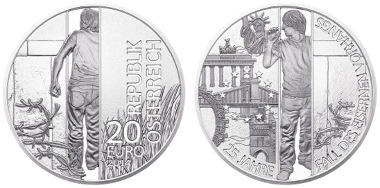June 26, 2014 – June 25, 2014, marks a significant milestone in global history as it was 25 years ago that the Iron Curtain began to crumble. The Austrian Mint is celebrating this momentous event with a silver coin that is being issued that day.
Austria/ 20 euros/ silver 900/ 20g / 34mm/ Design: Herbert Waehner/ Mintage: 50,000.
Mint engraver Herbert Waehner captured this moving time with a very meaningful coin design. The obverse shows a young man cutting through the Wall leaving behind the barbed wire of the communist world on the left side and going towards freedom and greener grass on the right side.
The reverse of the coin shows the young man coming through the wall and into freedom. The barbed wire is now behind him and he looks forward to see global symbols of freedom: the Statue of Liberty, the Brandenburg Gate (which was on the very front of this wall), the Elisabeth bridge connecting eastern Hungary to the West, the giant Ferris wheel of Vienna and the Charles Bridge in Prague, all symbols that bridge to the free world. Superimposed on this are the stars of a free and united Europe.
1989: The pan-European picnic – the first “official” opening of the Iron Curtain / http://creativecommons.org/licenses/by-sa/3.0/deed.en.
On June 27, 1989 the foreign ministers of Austria and Hungary met at the barbed wire fence along these borders, separating the West from the East. The time had come for the end of the divide in post-war Europe. A picture flashed around the world that showed these men wearing suits and using a heavy wire cutter together cutting through the barbed wire, thus marking the beginning of the end of communism in Europe and the crumbling of the Iron Curtain.
The complex concrete wall in Berlin was breeched November 9, 1989. Within just 5 months the end of the physically divided East and West had come – a dream come true for so many people.
The notorious Wall was 155 km long, of which 43 were in Berlin. There were 302 watchtowers, along with 105.5 km of anti-vehicle ditches, as well as 259 dog runs. It was a formidable barrier through which more than 100,000 easterners tried to escape. It is thought that more than 600 were killed in these attempts either shot or killed by the guards, or by their own escape efforts (such as drowning), or committed suicide when they were caught.
Mauerspechte (woodpeckers) chipping away pieces of the wall. Source: Superikonoskop/ http://creativecommons.org/licenses/by-sa/3.0/deed.en.
Today only one kilometer of the Wall still stands as a memorial to these years and all that happened. Many people, who were called Mauerspechte (wall woodpeckers), chipped away at the wall and took home a piece as a memento. In the city of Berlin there is a continuous line built into the streets, sidewalks and parks, which delineates where the wall used to stand. The Brandenburg Gate has been restored and one may once again walk freely through the Gate and along the lovely boulevard of Unter den Linden, passing by the many elegant buildings of by-gone times some of which are now embassies, as well as the newly built, very modern and massive US Embassy.
Find out more about the history of the Berlin Wall on this highly informative and entertaining website including texts, images, videos and sound recordings.
The official website of the City of Berlin also provides a vast range of links to documentaries, virtual museums and more.
If you want to know more about the artist, Herbert Waehner, we have made an interview with him. And he told us that this coin is one of his favourites.
Or visit the Austrian Mint Shop Online.






